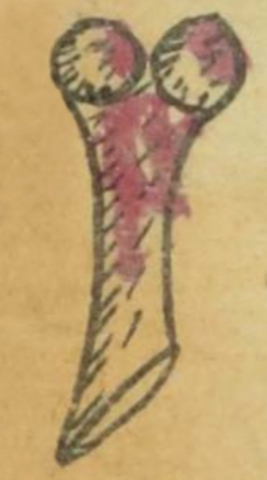Omiton (MH517v)
This black-line drawing of the compound glyph for the personal name Omiton (attested here to be a man's name) shows an upright bone (omitl), perhaps a femur, with an epiphysis at the top (two pronounced round knobs). The bottom of the bone is cut at an angle. The bone has some three-dimensional shading. It is also partly colored red (somewhat pinkish or purple, but perhaps a reference to blood, so meant to be red?) in the top half. The relative size of the bone cannot be determined without a comparison, and so the diminutive nature of this one (tontli) was not apparently made visual.
Stephanie Wood
Bones of sacrifical victims were preserved as were ancestors' bones. Bones were made into tools (e.g., for weaving, as shown below) and percussion instruments (such as a rasp found in the Codex Vindobonensis). They were sometimes incised with glyphs and iconographic designs, as seen in this image published by Mexicolore.
Mexicolore has a number of illustrated articles about bones in Nahua cultures, such as the one mentioned already about musical instruments, but also about bone healing, bones and surgery, bones and burials in pots, and the stealing of bones by Quetzalcoatl from Mictlan.
Stephanie Wood
dio omitō
Diego Omiton
Stephanie Wood
1560
Jeff Haskett-Wood
bones, huesos, blood, sangre, nombres de hombres, hueso

omi(tl), bone, https://nahuatl.wired-humanities.org/content/omitl
-tontli, smallness, https://nahuatl.wired-humanities.org/content/tontli
El Huesito
Stephanie Wood
Matrícula de Huexotzinco, folio 517v, World Digital Library, https://www.loc.gov/resource/gdcwdl.wdl_15282/?sp=114&st=image
This manuscript is hosted by the Library of Congress and the World Digital Library; used here with the Creative Commons, “Attribution-NonCommercial-ShareAlike 3.0 License” (CC-BY-NC-SAq 3.0).




